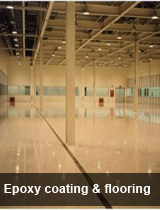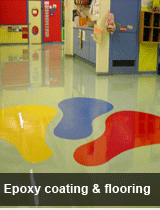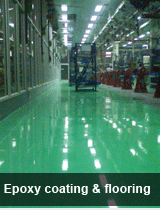



Hot News 
Epoxy coating & flooring
Epoxy coating & flooring
are extremely beneficial for manufacturers and those in the industrial sectors. Concrete repairs are facilitated by epoxy coatings, industrial mechanisms are protected by epoxy coatings, and flooring that's subjected to the tough demands inside manufacturing warehouses is safeguard by epoxy flooring merchandise. In brief, epoxy coatings are used as floor coatings that resist wear, and equipment coatings that resist rust. These are the uses for industrial coatings … but what's epoxy anyway?
Epoxies are polymer components which begin as liquids and are chemically transformed into a solid. An epoxy based polymer is mechanically strong, chemically resistant to degradation in the chemical components within the solid form and very adhesive during conversion from liquid to solid. You'll find a wide range of simple epoxy chemicals by which an epoxy technique might be formulated.
Physically epoxy systems contain two components, resins and hardeners. The resin component is typically light-colored, often almost clear colored and nearly odor totally free. Hardeners are typically dark and have a slight odor. When these two components are mixed, they are going to chemically and bond together when the chemical reaction has total, they are going to form a powerful and rigid plastic material.
Applications of epoxy based materials are extensive and contain epoxy coatings, adhesives and composite materials like carbon fiber and glass-reinforced plastic (though polyester, vinyl ester, along with other thermosetting resins are also used for glass-reinforced plastic). Epoxies are recognized for their excellent adhesion, chemical and heat resistance, good to outstanding mechanical qualities and very excellent electrical insulating properties.
Why use an Epoxy?
Epoxy coatings are used due to their superb chemical resistance, durability, low porosity and robust bond strength. Much better protective coatings are obtainable but not as typical, are field applied, brush-on, roll-on, or trowel-on coatings.
While epoxy floors are really frequent, for important and demanding applications the epoxy is either combined with, or applied under and above, quartz (sand) or aluminum oxide grains. In any event, the result is truly a quartz or aluminum oxide floor, held in location using the epoxy. The quartz, and frequently greater the aluminum oxide, is much more long lasting and wear resistant than the epoxy alone.
Epoxies contain a 'base' as well as a 'curing' agent. The two substances are mixed in a certain ratio. A chemical reaction occurs between the two parts generating heat (exothermal) and solidifying the amalgamation into an inert, hard 'plastic'.
Some epoxies yellow, chalk (or a lot more frequently suffer a loss of their gloss), in direct sunlight (UV). The yellowing might be a real difficulty. For pigmented epoxies choose colors which are dark or include a whole lot of yellow (such as green). Even clear epoxies will yellow and get cloudy. Typically epoxies have a tendency to be best coated with latex or urethanes which will retain their color and attractive gloss. This can be particularly true if color coding or matching business colors is crucial.
After the two epoxy parts are blended there is a working time (pot life) in the course of which the epoxy may be applied or used. Normally the pot life will probably be anyplace from minutes to one hour or longer. At the end of the pot life the mixture becomes quite warm (or maybe dangerously hot) and speedily begins to harden.
Epoxies will harden within minutes or hours, but complete cure (hardening) will usually take many days. Most epoxies is going to be suitably challenging within a day or so, but may require much more time to harden before the coating can be sanded.
Epoxies are difficult and brittle by nature. Additives might be added to epoxies that may make them less brittle, but normally at the loss or reduction of other positive epoxy properties for example chemical resistance.
You can find unique epoxy formulations which have increased chemical resistance, increased temperature resistance, as well as the capacity to be applied under water.

